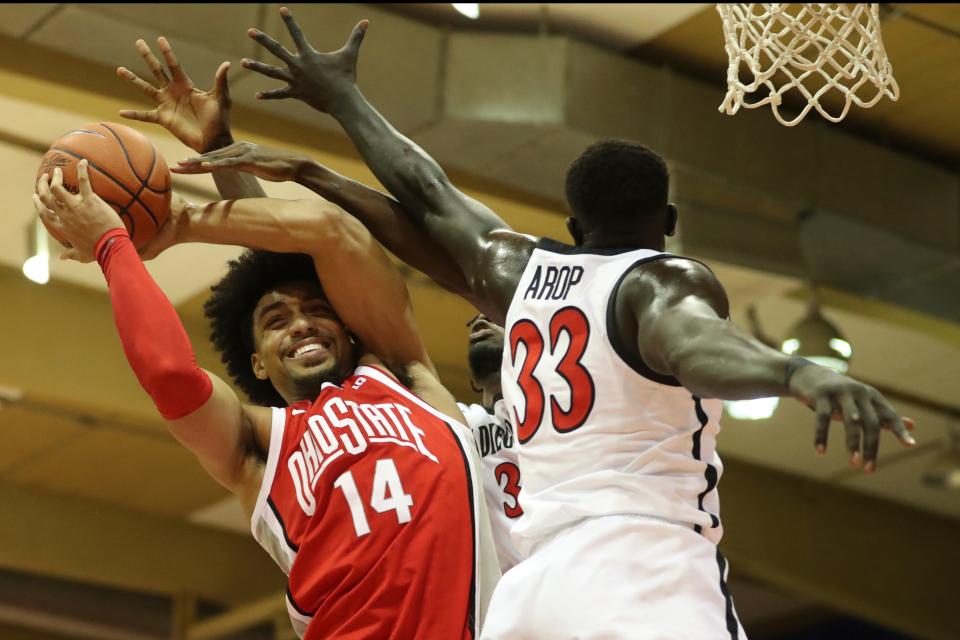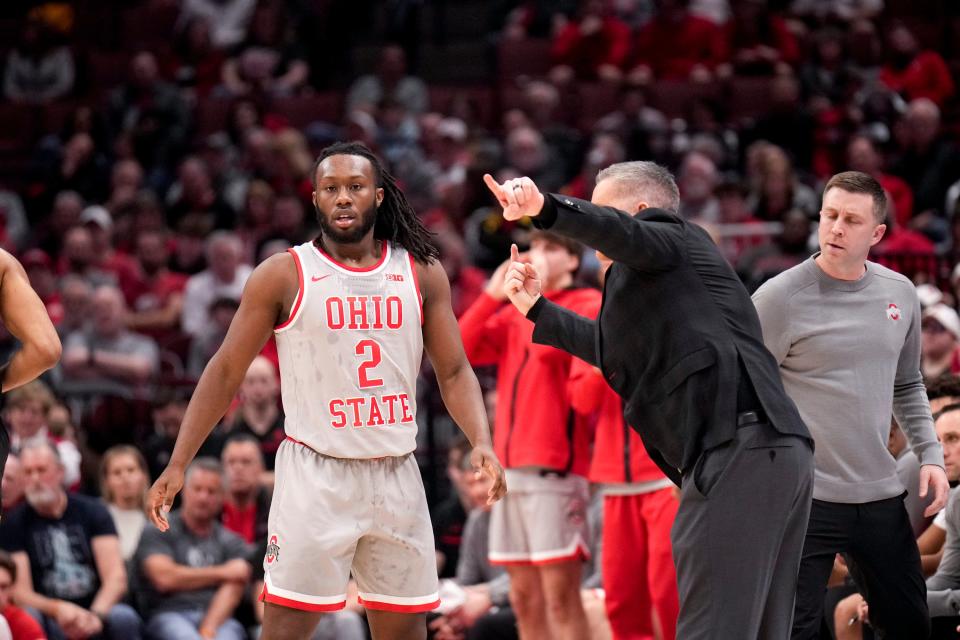What did Ohio State-San Diego State in Maui foreshadow about the season?
A lot can change in 133 days.
On November 21, Ohio State and San Diego State, both 3-0, met in the Maui Invitational. San Diego State was ranked No. 17 in the Associated Press poll at the time, while Ohio State was third among teams also receiving votes, putting them at No. 28.
For 307 seconds, the Buckeyes led the Aztecs. Ohio State scored first and built a five-point lead in the opening minutes, but it was as unsustainable as a more experienced, more physical and ultimately more talented San Diego State team took the lead with 12:37 left in the first half and never trailed again in an 88-77 win.
From there, it was a tale of two decidedly different seasons. Monday night, San Diego State became the first Ohio State opponent to play for a national championship since Big Ten rival Michigan fell to Villanova in the 2018 title game.
While the Aztecs came up short, 76-59, against No. 4 seed UConn in their bid to win it all, it was still a better finish for them than for Ohio State, which wrapped up its season with a Big Ten Tournament semifinal loss to Purdue in Chicago on March 11.
Ohio State Buckeyes: Join the Ohio State Sports Insider text group with Bill Rabinowitz, Joey Kaufman Adam Jardy
Here’s a look at that meeting between the Buckeyes and Aztecs and what it signaled about what was to come for Ohio State in 2022-23.
Roster continuity matters
Although Ohio State would trail for more than 75% of the game and ultimately lose by 11 points, the Buckeyes continually threatened to make it interesting by pulling within six or seven. But each time they needed one more stop and one more bucket to seriously challenge for the lead, San Diego State had the answer.
“I think it's experience,” coach Brian Dutcher explained after the game. “I think I have five fifth-year seniors. So these guys have been in a lot of those moments, whether it was here at San Diego State for their entire career or whether it was at Cal or Oakland University or TCU or wherever they came from. They have been in a lot of important games.
“There's no greater teacher than experience. I think their experience showed out.”

According to KenPom.com, the Aztecs’ roster had an average Division I experience of 2.96 years per player, the 21st most in the nation. On top of that, they were 39th nationally in minute continuity, returning 61.0% of their minutes from the 2021-22 season.
Ohio State’s roster averaged 2.37 years of Division I experience (90th nationally) and returned only 12.4% of its minutes from the prior season. That was good for 346th most in the country.
It showed in that game, and it showed as San Diego State piled up later wins.
“The last couple minutes of the game, it could either have went either way because they're really forcing us, pushing up the tempo, and we just battled it out and got the W,” San Diego State’s Matt Bradley said. “But no discredit to Ohio State. They're a great team. They challenged us. But, yeah, we've been battle-tested, and we're going to keep going.”
Defense is critical
At 101.6 points allowed per 100 possessions, Ohio State finished the year ranked 106th nationally in adjusted defensive efficiency according to KenPom. Teams shot 49.3% from two-point range against the Buckeyes, the highest mark allowed since the 2001-02 season, and had an effective field goal percentage of 48.9%, which marks the worst performance in that category during coach Chris Holtmann’s six seasons.
In reaching the title game, San Diego State held its first four tournament opponents to 65 points or fewer. Then they faced Florida Atlantic in the Final Four, and the Owls scored 71. The Aztecs were fourth in adjusted defensive efficiency (90.3) and 20th in effective field goal percentage defense (46.5%) and held teams to 28.1% shooting from 3-point range – the third-best defense in the nation.
Ohio State basketball: 4 takeaways from Ohio State's Gene Brown III entering the transfer portal
In November, Holtmann was mentioning a need to get better defensively in the same breath as acknowledging his team’s inexperience.
“I think they have a better just collective probably feel for each other than what we do right now, which is a little bit to be expected given where we're at,” he said. “That's going to be a common theme. But I don't want to make excuses for our guys. We have to, as coaches and players, have to just defend better.”
Offense couldn’t overcome porous defense
It was a sign of things to come.
By pouring in 77 points, Ohio State managed to score more against the Aztecs than any other team San Diego State beat. It still ended up as an 11-point OSU loss.
The Buckeyes had an adjusted offensive efficiency rating of 107.2 that night, and OSU would finish the season with a 4-13 record when having an adjusted offensive efficiency rating equal to or below that and was 12-6 when topping it.
Bright days ahead for Bruce Thornton, Brice Sensabaugh
Ohio State started four veterans and just one first-year player against San Diego State. That first-year player was Bruce Thornton, who would end up logging 25 minutes and scoring 13 points. He had three of OSU's nine assists and just one of its eight turnovers.
While Thornton would struggle midway through the season, he would finish strong. On the year he averaged 10.6 points, handed out a team-high 92 assists with only 46 turnovers and played a team-high 1,068:49.

A reserve in the early portion of the season, Brice Sensabaugh finished second among the Buckeyes with 17 points in the loss. He was the team’s leading scorer in 2022-23 at 16.3 points per game and is now going through the NBA draft process.
Get more Ohio State basketball news by listening to our podcasts
This article originally appeared on The Columbus Dispatch: In Maui, Ohio State got early look at dangerous San Diego State
